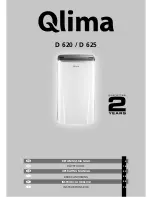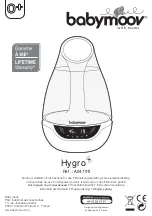
1-800-533-7533
HI-E DRY 100
Installation, Operation and Maintenance Instructions
11
www.QuestProtect.com
quest
Asset Protection and IAQ Solutions
quest
quest
quest
The following procedure is effective only if the system is monitored after replacing the compressor to insure
that the clean up was complete.
1. This procedure assumes that the previously listed compressor motor circuit tests revealed a shorted or
open winding. If so, cautiously smell the refrigerant from the compressor service port for the acid odor of
a burn out.
WARNING: The gas could be toxic and highly acidic. If no acid odor is present, skip down to the section
on changing a non-burn out compressor.
2. Remove and properly dispose of the system charge. DO NOT vent the refrigerant or allow it to contact
your eyes or skin.
3. Remove the burned out compressor. Use rubber gloves if there is any possibility of coming in contact
with the oil or sludge.
4. To facilitate subsequent steps, determine the type of burn out that occurred. If the discharge line shows
no evidence of sludge and the suction line is also clean or perhaps has some light carbon deposits, the
burn out occurred while the compressor was not rotating. Contaminants are therefore largely confined to
the compressor housing. A single installation of liquid and suction line filter/driers will probably clean up
the system.
If sludge is evident in the discharge line, it will likely be found in the suction line; this indicates the
compressor burned out will running. Sludge and acid have been pumped throughout the system. Several
changes of the liquid and suction filter/driers will probably be necessary to cleanse the system.
5. Correct the system fault that caused the burn out. Consult the factory for advice.
6. Install the replacement compressor with a new capacitor and an oversized liquid line filter.
In a running burn out, install an oversized suction line filter/drier between the accumulator and
compressor. Thoroughly flush the accumulator with refrigerant to remove all trapped sludge and to
prevent the oil hole from becoming plugged. A standing burn out does not require a suction line filter/
drier.
7. Evacuate the system with a good vacuum pump and accurate vacuum gauge. Leave the pump on the
system for at least an hour.
8. Operate the system for a short period of time, monitoring the suction pressure to determine that the
suction filter is not becoming plugged. Replace the suction filter/drier if pressure drop occurs. If a severe
running burn out has occurred, several filter/driers may have to be replaced to remove all of the acid and
moisture.
NOTE: NEVER use the compressor to evacuate the system or any part of it.
5.6C Replacing a Compressor- Non-Burn Out
Remove the refrigerant from the system. Replace the compressor and liquid line filter/drier. Charge the
system to 50 PSIG and check for leaks. Remove the charge and weigh in the refrigerant quantity listed on the
nameplate. Operate the system to verify performance.
5.7 Relay
The contacts of the single pole, single throw relay complete the power circuit to the compressor. The
contacts are closed when power is provided to the relay coil via the control circuit. The control circuit
includes the humidity control, defrost thermostat and timer.


































